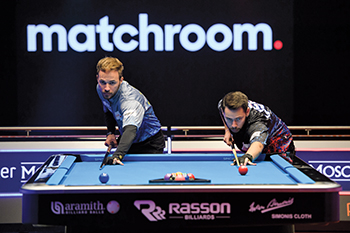The recent Mosconi Cup showed the importance of the lag.
Fast on the heels of the recently played Mosconi Cup, the big topic in pool is the lag.
No matter what the race is, the lag is critical in any alternate break format. Obviously, the importance is heightened in the Mosconi Cup, where 10 of the best players in the world battle in races to five. And, with the chances of making a ball on the break being 80-90 percent? Well, enough said.
If you watched the 2020 Mosconi Cup, you noticed that the lack of lags won by Team USA proved to be fatal in a number of matches. Team Europe won 11 of 14 lags and won four out of five hill-hill matches. Three of those Europe wins were decided by break-and-runs in the case game. Thatís a massive advantage at that level. It would seem that one team put some work into the lag and one team didnít. We can all guess which was which.
If lack of attention to the lag was, indeed, part of the problem for Team USA, I find that staggering. In every Mosconi Cup in which I played, we spent a lot of time on the lag and working on the best way to lag. Itís never easy to master the lag on brand new tables with new cloth. You rely so much on feel and touch. My plan was to always get the cue ball to hit the second rail and try to keep it between the end rail and half a diamond out. This way I know I would rarely be short. Thatís what got the best of Team USA on a number of occasions.
The thing about the Mosconi Cup is that you are not allowed to practice on the match table, so you donít have the luxury of getting a feel for the table and rails before you lag. What we always did was try to make the conditions on the table in the practice room as close to those of the match table. I donít know about Team USA, but Team Europe polished the cue ball and put a heater under the table in the practice room. Preparation is key at any level.
When I lag, I like shooting to hit the second rail because that approach allows you to let your stroke out a little more. Trying to be perfect on a super-fast table is very difficult. It makes you tentative with the lag, which adds a little tension in the arm.

The importance of the lag is amplified in short-race, alternate-break formats like Mosconi Cup.
In events in which I do get to practice on the match table, I always try a few lags. First, I like to hit the ball against all the rails to get a feel for the rails and the speed.
A lot of people ask where I hit the cue ball on lags. I always play with follow to get the cue ball rolling naturally forward. I see a lot of players hit center cue ball. Thatís a no-no because the cue ball will slide before it begins rolling forward and will make it a lot harder for you to get a good feel for the shot and for you to be able to judge the speed. And again, I try to hit the second rail and get the cue ball to stop in the area between the rail and halfway to the first diamond. Do that consistently and I will guarantee you will win at least 75 percent of your lags. And that consistency will show up in your overall results as well.
Over the years, Iíve played in hundreds of hill-hill matches, a number of them in tournament majors. Iím pretty sure I broke in the hill-hill game 75 percent of the time, and I probably have a 75 percent success rate. I think thatís a pretty good percentage, but a success rate that high is only possible by winning the majority of lags. There is nothing worse than sitting in your chair and hoping and praying for another opportunity at the table. We would all rather have our destiny in our own hands, and that starts with winning the lag.





